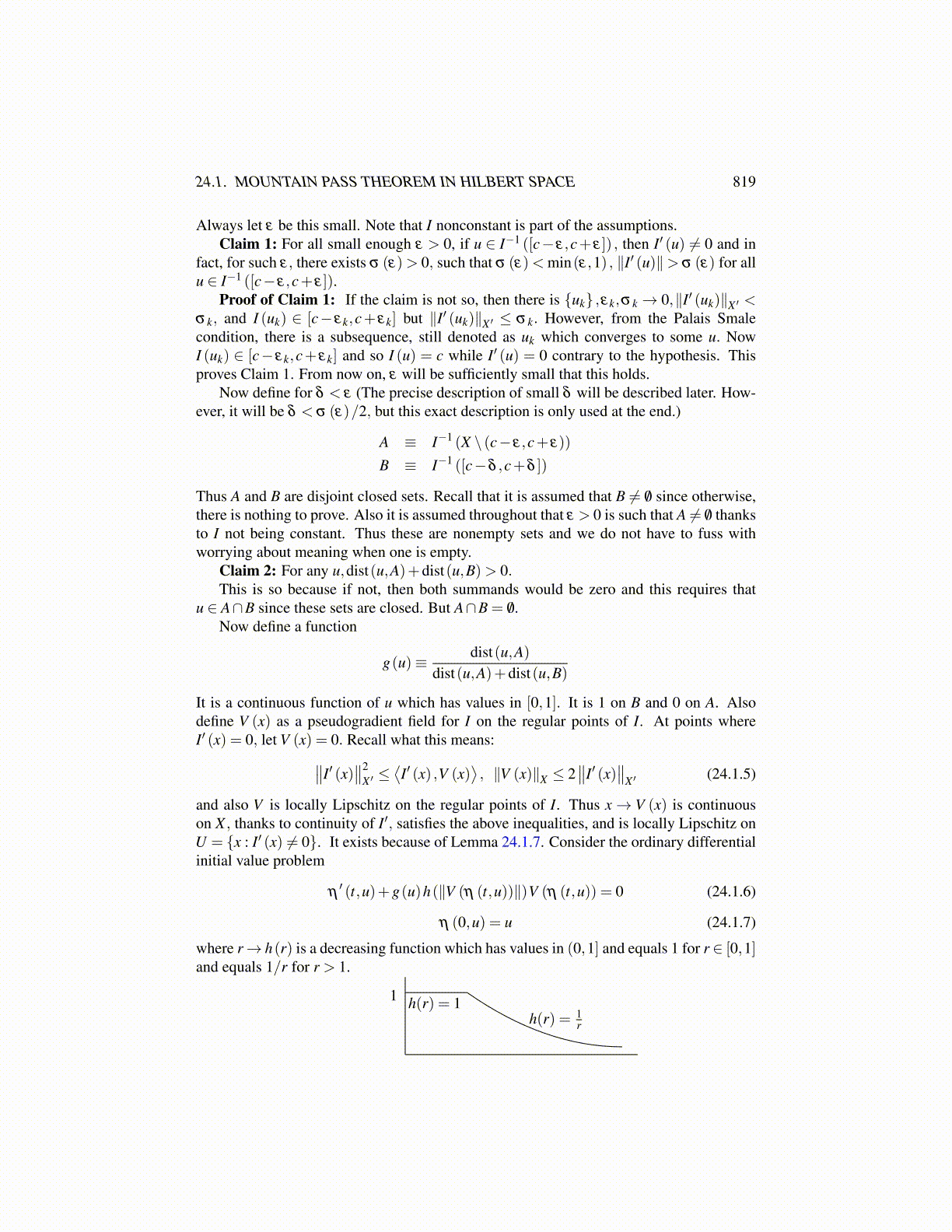
24.1. MOUNTAIN PASS THEOREM IN HILBERT SPACE 819
Therefore, assume I−1 ([c−δ ,c+δ ]) ̸= /0 for all δ > 0. Since I is nonconstant, ε > 0can be chosen small enough that
I−1 (X \ (c− ε,c+ ε)) ̸= /0.
Always let ε be this small. Note that I nonconstant is part of the assumptions.Claim 1: For all small enough ε > 0, if u ∈ I−1 ([c− ε,c+ ε]) , then I′ (u) ̸= 0 and in
fact, for such ε, there exists σ (ε)> 0, such that σ (ε)< min(ε,1) , ∥I′ (u)∥> σ (ε) for allu ∈ I−1 ([c− ε,c+ ε]).
Proof of Claim 1: If the claim is not so, then there is {uk} ,εk,σ k → 0,∥I′ (uk)∥X ′ <σ k, and I (uk) ∈ [c− εk,c+ εk] but ∥I′ (uk)∥X ′ ≤ σ k. However, from the Palais Smalecondition, there is a subsequence, still denoted as uk which converges to some u. NowI (uk) ∈ [c− εk,c+ εk] and so I (u) = c while I′ (u) = 0 contrary to the hypothesis. Thisproves Claim 1. From now on, ε will be sufficiently small that this holds.
Now define for δ < ε (The precise description of small δ will be described later. How-ever, it will be δ < σ (ε)/2, but this exact description is only used at the end.)
A ≡ I−1 (X \ (c− ε,c+ ε))
B ≡ I−1 ([c−δ ,c+δ ])
Thus A and B are disjoint closed sets. Recall that it is assumed that B ̸= /0 since otherwise,there is nothing to prove. Also it is assumed throughout that ε > 0 is such that A ̸= /0 thanksto I not being constant. Thus these are nonempty sets and we do not have to fuss withworrying about meaning when one is empty.
Claim 2: For any u,dist(u,A)+dist(u,B)> 0.This is so because if not, then both summands would be zero and this requires that
u ∈ A∩B since these sets are closed. But A∩B = /0.Now define a function
g(u)≡ dist(u,A)dist(u,A)+dist(u,B)
It is a continuous function of u which has values in [0,1]. It is 1 on B and 0 on A. Alsodefine V (x) as a pseudogradient field for I on the regular points of I. At points whereI′ (x) = 0, let V (x) = 0. Recall what this means:∥∥I′ (x)
∥∥2X ′ ≤
⟨I′ (x) ,V (x)
⟩, ∥V (x)∥X ≤ 2
∥∥I′ (x)∥∥
X ′ (24.1.5)
and also V is locally Lipschitz on the regular points of I. Thus x→ V (x) is continuouson X , thanks to continuity of I′, satisfies the above inequalities, and is locally Lipschitz onU = {x : I′ (x) ̸= 0}. It exists because of Lemma 24.1.7. Consider the ordinary differentialinitial value problem
η′ (t,u)+g(u)h(∥V (η (t,u))∥)V (η (t,u)) = 0 (24.1.6)
η (0,u) = u (24.1.7)